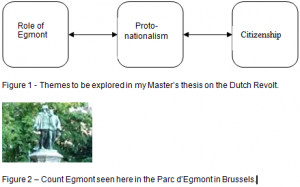Benjamin A. Johnson and Dr. Donald Harreld, History
Background
My goal was to investigate the significance of the beheading of Count Lamoral Egmont, a popular Dutch patriot who opposed foreign Spanish rule in Brussels in the late sixteenth century. Egmont, chief magistrate of the southern Netherlands, stood for tolerating Protestants and was executed for opposing the Spanish overlords. Egmont’s death largely mobilized the Dutch speaking peoples’ desire for independence from Philip II, the Spanish king.
Research Approach and Conclusions
In my study, I explored events of the resistance and the resulting impact on the European Enlightenment. I sought to find out how Egmont’s story translated into historical saga, high literature, and music. More importantly I wanted to find out how Egmont became a symbol of man’s quest for freedom, a major item on the agenda in the eighteenth century.
My research strategy took many venues. In Winter Semester of 2004, I enrolled in History 490 (European Religion and Culture) where I learned about Protestantism in detail and wrote a twenty page paper on Calvinism in the Dutch Revolt. I also did background research on Egmont to prepare me for my trip to Belgium in the spring of 2004. I utilized secondary sources in English, Dutch, French, and German from the BYU library to help me discern how historians have interpreted the events surrounding Egmont’s death and how his fatality affected the Dutch Revolt. Additionally, I consulted original materials in the Belgian State Archives in Brussels and the Dutch National Archives in The Hague to further aid me in my research.
My experience in Brussels was invaluable. I am indebted to the ORCA Grant and to Dr. Don Harreld, who taught me how to use the Belgian National Archives and who helped me develop valuable skills in historical research. This groundwork in turn enabled me to navigate through other archives and libraries which I visited in the Low Countries to help me with my project.
This international experience provided me with many learning opportunities to enhance my future career in history. I gained additional knowledge about the past and learned to interpret the paleography of sixteenth century French. I also (with permission from the archives) photographed several pages of French and Dutch documents which I am currently transcribing and translating into English.
There have been obstacles and unexpected findings in my research. Sixteenth century French handwriting is more difficult to read than I had anticipated and so the reading of the materials has become a longer task than expected. There were also more interpretations of Egmont than I had realized. Some look at Egmont as an unfaithful follower of the Catholic Church, while others have looked at him as a freedom fighter. Others still, see him as a victim of circumstance who was loyal to Philip II to the end. His death was romanticized two centuries later by Friedrich Schiller whose history of the Netherlands largely influenced Schiller’s friends, Goethe and Beethoven. Egmont has thus come under various (and sometimes conflicting) interpretations throughout the centuries since his death.
On the whole, my research plan worked out how I had predicted. I experienced success in my research in Provo, Brussels, and The Hague and developed a strong desire to continue with my topic and make it the subject matter of my Master’s thesis. While the question of Egmont’s role in the Dutch Revolt is complex and not entirely discernable, Egmont has played an important part in the self image of the Belgians and Netherlanders.
Further Research and Development
Egmont’s place in the history of the Dutch Revolt remains controversial. Nevertheless, in my thesis I intend to produce an evenhanded account of Egmont’s role in that period. Finally, this mentoring experience allowed me to gather essential information for my thesis work, and I anticipate that this project and my thesis will serve as groundwork for my doctoral dissertation.

